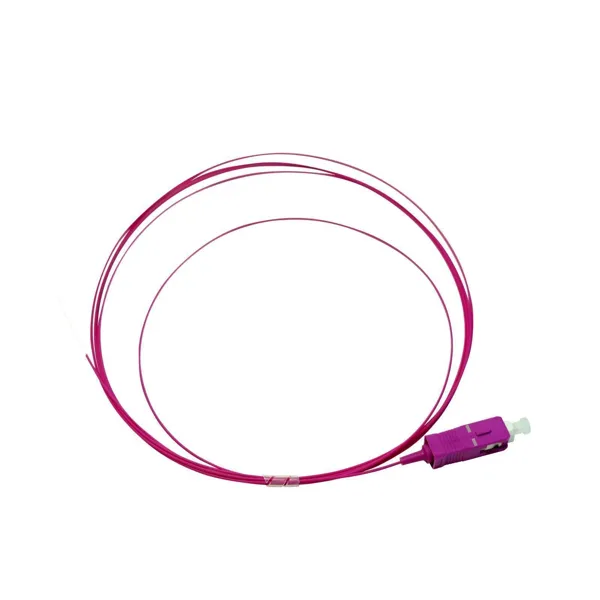OSCPC2OM4-P - Pigtail patch cable MM OM4 2m LSFH indoor SCPC (900m)
Multi-mode (MM) fibre optic pigtail patch cable. One end is pre-assembled with an SC/PC connector, the other end is without a connector. This allows the pigtail to be easily connected to a fibre optic cable.
The 900μm sleeve is of the LSFH type and is recommended for indoor use.
The cable is fitted with a short sleeve at one end, which facilitates installation in flush-mounted junction boxes and prevents attenuation increases due to unwanted bending. In addition, the short sleeve makes it easier to insert the patch cable into the empty conduits, reduces the space required for the connection and the bending radius is smaller.
Highlights
- Fibre optic type: Multimode OM4 ITU-T G.651.1
- LSFH jacket, magenta
- SC/PC connectors
- 2m long
Multimode fibre types
Multimode (MM) optical fibres can transmit more than one wavelength at the same time, allowing several signals to be transmitted simultaneously. Their main advantage over single-mode (SM) fibres is the lower cost of both the fibre and the optical equipment, making them an ideal solution for short distances, e.g. in corporate networks, communication rooms or data centres.
Multimode fibre optic cables are divided into 5 categories, called OM (Optical Multimode). They range from OM1 to OM5, and differ mainly in their transmission speed in relation to distance.
Multimode fibres also differ in other factors:
-OM1 fibres have a core diameter of 62.5μm, while OM2, OM3, OM4 and OM5 fibres have a smaller core of 50μm
-OM1 and OM2 were developed first. They are designed for use with LED light sources and are no longer used today as they are not suitable for high-speed networks. The subsequent OM3, OM4 and OM5 categories were developed for use with laser emitters (VCSEL), which achieve a higher bandwidth and speed
-OM3 and OM4 fibres work with wavelengths of 850 nm, but OM5 fibres have been optimised for WDM (Wave Division Multiplexing) applications. They can transmit up to 4 channels at higher wavelengths (880, 910 and 940 nm), resulting in a very high bandwidth
What is the difference between OM3 and OM4?
Among the various categories of multimode (MM) fibres, OM3 and OM4 fibres are the most widely used today, as they offer high transmission speeds and bandwidths at an affordable price. The OM4 fibre is a further development of the OM3 fibre which, thanks to its improved internal structure, has a lower attenuation and can therefore operate with a higher bandwidth than the OM3 fibre and reach greater distances.













